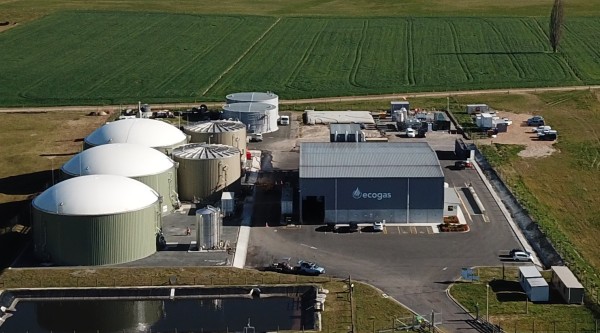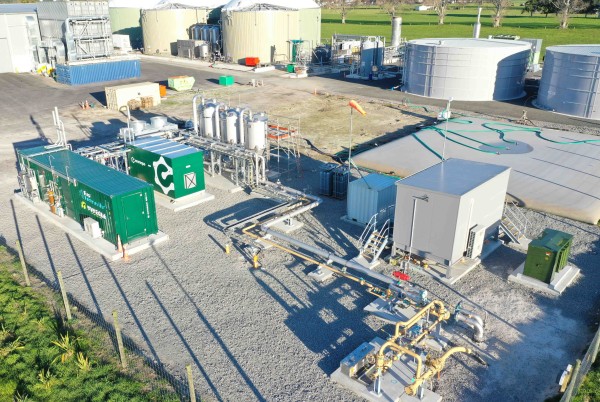How do you turn kumara peel and banana skins into renewable energy and biofertiliser? Here’s how kerbside food waste is collected in Auckland, processed at Ecogas’ organics processing facility in Reporoa, and then turned into renewable gas once processed through First Renewables biogas upgrade facility.
Food waste is collected at the roadside
In Auckland, food waste bins are collected at the roadside and are sent to the new high-tech Reporoa facility.
This is a considerable improvement on throwing our food waste into landfill, which according to research by Rabobank and Kiwi Harvest Food Waste estimates that the value of food waste per NZ household is worth about $1510 per year. Nationally this equates to $3.2 billion of wasted food. Reducing food waste to landfill also reduces the amount of methane and carbon dioxide released into the atmosphere.
The scraps are prepared for processing

The Ecogas Organics Processing facility and digestors.
Once the food waste arrives in Reporoa, it is checked for contaminants or plastics. The food waste is then mashed into a thick liquid, ready to be put into huge vats – the anaerobic digesters.
The waste is anaerobically digested
The liquid waste goes into the anaerobic digesters. These are sealed containers, which allow bacteria to break down organic waste without oxygen (anaerobic means without oxygen). Reporoa has three digesters, each one with a capacity of 3,500m3. The waste is broken down in a four-stage process and at the end of this, two products are produced: biogas and digestate.
Biogas is the mixture of gases that is created by the digestion process and collects in the top dome of each digester. It is mainly methane and carbon dioxide, along with some other trace gases.
Digestate is a mixture of the remaining undigestible material and any dead bacteria. It stays behind as a nutrient-rich liquid which can be used as a biofertiliser.
The biogas is upgraded
Biogas can be used as it is, but the methane content of biogas varies considerably, which means its energy content also varies and it can be corrosive. To create a more reliable and purer product, biogas can be upgraded into biomethane and renewable carbon dioxide.
A large proportion of the biogas produced by the Ecogas digesters will now go into the First Renewables biogas upgrade facility. The biogas is first processed to remove any impurities and then passed through a dehumidifier to get rid of moisture. Finally, the biomethane and renewable carbon dioxide are separated and each gas is captured. From there, the biomethane can be piped directly into the natural gas grid, because it is chemically identical to natural gas. The renewable carbon dioxide, or bioCO2, is sent to a nearby glasshouse to enhance the growth of tomatoes (but it could be compressed and bottled for sale).

Aerial view of the First Renewables biogas upgrade facility in Reporoa.
The end products are used in many ways
The end products of the food waste processing journey are all used to support lower emissions and a more circular economy:
- The digestate is used as liquid biofertiliser on farms near Reporoa, reducing the need for imported and/or synthetic fertiliser.
- Biogas is used to power the Ecogas facility and heat up the T&G Fresh glasshouses nearby.
- BioCO2 could be used by the food and beverage industry in the future, as a net zero emissions alternative to the standard CO2. It is used to extend the shelf-life of food, make drinks fizzy and keep frozen foods cold during transport.
- Biomethane is piped into the Firstgas grid, which displaces the need for natural gas. Ecogas Chief Technical Officer, Alzbeta Bouskova Houghton says enough biomethane will be produced to supply around 7,200 Kiwi homes with net zero carbon gas.
At the end of this process, the kumara peel you put into your food bin has been turned into products that power New Zealand and help us grow more food, more sustainably. This helps contribute to a more circular economy, with less waste and more reusing and recycling.
To learn more about how Clarus businesses Firstgas and First Renewables are supporting the transition to a net carbon neutral New Zealand, visit Future of Energy.





